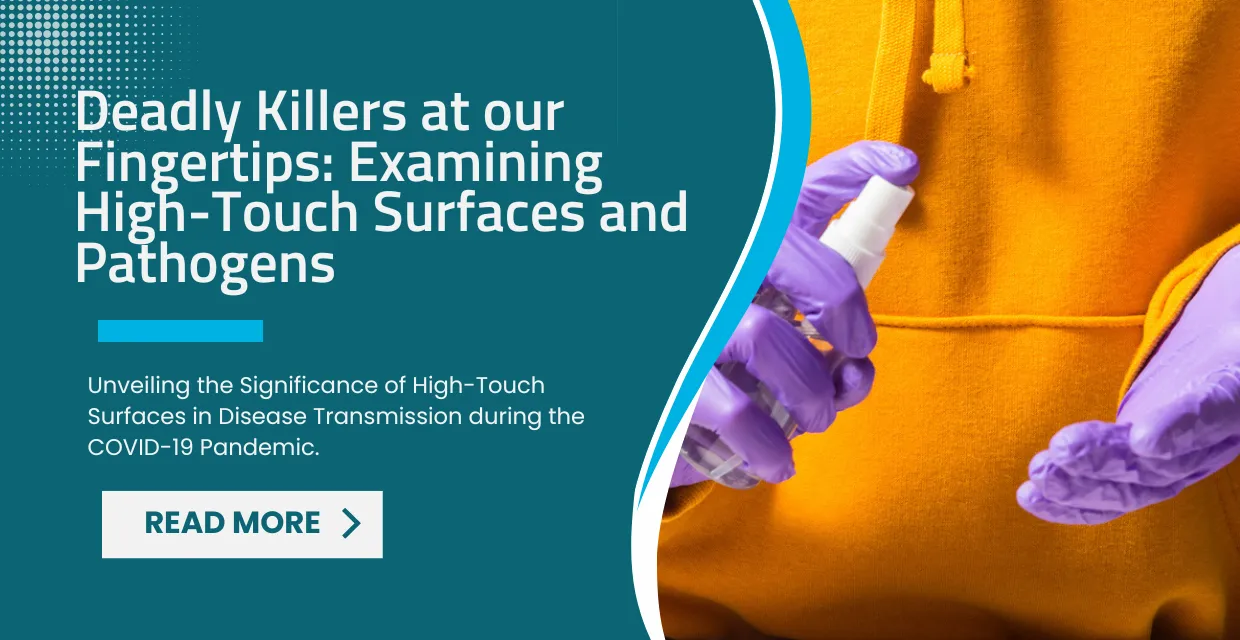Innovations in Joint Replacement: Paving the Way for Pain-Free Movement
Joint pain and mobility issues can significantly impact a person's quality of life. Fortunately, medical advancements in joint replacement surgery have revolutionized...

In the wake of a global health crisis, awareness of high-touch surfaces and their potential role as vectors for pathogens has significantly increased. At LifeCare Hospitals, we recognize the importance of understanding these potential hotspots for infection.
High-Touch Surfaces: Silent Carriers of Pathogens
High-touch surfaces are ubiquitous, encompassing doorknobs, elevator buttons, handrails, light switches, and more. While seemingly innocuous, these surfaces have the potential to harbour a variety of pathogens, including viruses and bacteria. Due to their frequent contact with multiple individuals, high-touch surfaces can become silent carriers of harmful microorganisms, contributing to the spread of infectious diseases.
The Hidden Threat: Pathogens on Surfaces
High-touch surfaces may appear innocuous, but beneath their seemingly ordinary exteriors lies a hidden threat - the presence of harmful pathogens. Microorganisms have a remarkable ability to survive on these surfaces for extended periods, and their survival is influenced by environmental factors such as temperature and humidity.
Microbial Persistence
Common pathogens, including the flu virus and bacteria like Staphylococcus aureus, linger on surfaces for hours to days. These invisible invaders can withstand adverse conditions, patiently waiting for the opportune moment to hitch a ride on unsuspecting hands.
Facilitating Transmission
Once transferred to hands, these pathogens gain easy access to the human body through common behaviours like touching the face or consuming food. The ease of transmission from contaminated surfaces to our hands and ultimately to our mucous membranes makes high-touch surfaces potent sources of infection.
Vigilance is Key
Understanding the persistence of pathogens on high-touch surfaces is vital in curbing the spread of infectious diseases. Regular handwashing and proper disinfection of surfaces can disrupt the transmission cycle, reducing the risk of infections.
The Role of Hand Hygiene
Handwashing is a time-tested and proven method of preventing the transmission of pathogens from our hands to our bodies. It involves using soap and water to lather the hands thoroughly, including the back of the hands, between the fingers, and under the nails. The act of scrubbing helps dislodge and remove harmful germs.
Hand Sanitizers
When soap and water are not readily available, hand sanitizers provide a convenient alternative. These alcohol-based solutions effectively kill many bacteria and viruses, including the flu virus and SARS-CoV-2, the virus responsible for COVID-19. Applying a palmful of sanitizer and rubbing it all over the hands until dry ensures optimal effectiveness.
Timing Matters
Regular and timely hand hygiene is critical. Handwashing should be performed before and after various activities, such as preparing or consuming food, using the restroom, and caring for someone sick. Additionally, hand sanitizers can be used in situations where handwashing facilities are not accessible.
The Impact on Public Health
Effective hand hygiene is essential for personal protection and plays a significant role in public health. By breaking the chain of pathogen transmission, we collectively contribute to reducing the spread of infectious diseases within our communities.
Environmental Cleaning and Disinfection
Routine cleaning and disinfection of high-touch surfaces are paramount in healthcare settings, public places, and homes. Hospitals, in particular, follow strict protocols to ensure these surfaces are regularly sanitized to minimize the risk of healthcare-associated infections.
The Importance of Regular Cleaning
High-touch surfaces, being constant points of contact, have the potential to harbor a multitude of pathogens. Routine cleaning is a foundational step in removing dirt, debris, and potentially harmful microorganisms from these surfaces, preventing their accumulation and subsequent transmission.
The Role of Disinfection
While cleaning removes visible contaminants, disinfection goes further by eliminating or reducing the number of pathogens on surfaces. Disinfectants with proven efficacy against various microorganisms are utilized to ensure a thorough sanitization process.
The Impact of a Global Pandemic
The global COVID-19 pandemic has cast a glaring spotlight on the significant role of high-touch surfaces in transmitting infectious diseases. The virus responsible for COVID-19, SARS-CoV-2, has demonstrated a remarkable ability to survive on surfaces for extended periods, prompting rigorous infection control measures to curb its rapid spread.
Silent Spreaders
High-touch surfaces, such as doorknobs, handrails, elevator buttons, and shared electronic devices, silently facilitate the transmission of the virus. Infected individuals may unknowingly leave traces of the virus on these surfaces, potentially infecting others who subsequently come into contact with the contaminated areas.
Survival on Surfaces
SARS-CoV-2 can remain viable on various surfaces, depending on surface material, temperature, and humidity. Studies have shown that the virus can persist on surfaces for hours to days, underscoring the importance of regular cleaning and disinfection to break the transmission cycle.
The Way Forward: Preventing Infection
Vigilance in maintaining clean and sanitized environments, coupled with individual efforts to practice good hand hygiene, is crucial in preventing the transmission of infectious agents. Understanding the risks associated with high-touch surfaces empowers us to proactively protect ourselves and those around us.
High-touch surfaces may be silent carriers of deadly pathogens, emphasizing the importance of infection prevention measures. LifeCare Hospitals is committed to promoting awareness and implementing rigorous infection control protocols. Together, we can navigate the challenges posed by high-touch surfaces, safeguarding our health and creating safer environments. Stay informed, stay cautious, and join us in pursuing a healthier and safer tomorrow.
Partager cet article